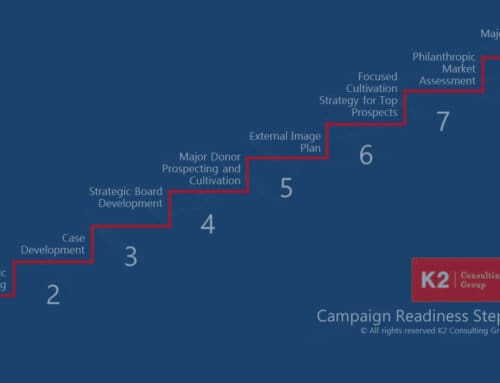Strategies for boards and staff to keep your donors from slipping away.
Why do organizations let donor relationships lapse when it costs so much to secure new ones?
Consider these real-life scenarios:
- Your campaign committee is reviewing a list of generous past donors: “Whatever happened to (pick a name)? He was so committed to our organization, even for years after he left the board.” “We should try to connect with him again.”
- A long-established donor retires out of state but for years maintains his allegiance. The colleague who recruited him rolls off the board, and he discontinues his support, thinking no one will notice. It turns out he’s right…
- An ardent supporter of the organization digs deep to make a generous multi-year commitment. Fundraising staff changes, and the relationship drifts. The donor wonders why. His interests have not changed; all that’s changed is the organization’s follow-through…
Top seven reasons why donor relationships wane:
- Leadership changes
As CEOs or development officers leave organizations, donor relationships inevitably transform. Strategic directions may change. Personalities may not mesh. In the worst case, fundraising may not have a place in a new CEO’s priorities, so donor outreach may devolve into mass appeals, email blasts, and event invitations. - Budgets contract
In periods of budget contractions, donor retention is considered a luxury. This is short-sighted and organizations always regret it later. Philanthropy is viewed as a distant second to earned income revenue — until that major campaign becomes necessary… - CEO and CDO performance metrics do not include donor retention
What gets measured gets done. Performance measurements are often based strictly on financials or campaign goal attainment. But donor goodwill is a tangible asset that can be measured – and squandered at an organization’s peril. - Focus on the now takes precedence over the future
Short-term results commonly claim the attention of leaders and boards: the current campaign or project, getting through the fiscal year, remaining viable, and myriad other reasons. Wise organizations focus on tomorrow (and raise lots more money). - Volunteers are not involved in donor retention
Board members can be the most persuasive promoters of the organization’s mission and solid foundation. Why ask them to solely review budgets when they can positively influence revenue through outreach to the organization’s investors? - Development officers are mired in management
It’s easy for fundraising professionals to get bogged down behind the desk and spend less time talking to key donors and stakeholders (especially in a discipline increasingly awash in technology). Sure, keep development managers in touch…but mostly in the field. - Donor divergence disrupts devotion
When donors raise questions or have divergent views, they are often avoided. Leaders that place ego, political interests or even job security over donor engagement can place the organization’s financial support at risk.
Donor relationships are not forever. Some are one-time-only gifts, and some donors’ interests and circumstances change over time. As with any human relationship, it’s a very special few that last a lifetime. How can you make your “special few” a “special many?”
Five retention strategies to adopt today:
- Recruit a Donor Retention Officer
Smart businesses and organizations prioritize customer retention, member retention, student retention, and patient retention. To make donor retention a high priority, put someone in charge. Paid professional or volunteer, hold them accountable for results. Responsibilities might include managing records, conducting basic research, choreographing staff and board retention activities, calling donors, and reaching out to lapsed donors before too much time passes. If you can’t carve out an FTE, spread these activities among various individuals. - Blend retention into your board culture
Your organization will stand above peers if your donor appreciation calls come from board members. Imagine one community leader telling another: “Do you know I received a call from the (fill in the blank)? One of their trustees called to thank me for my recent gifts and asked for my thoughts about their services. I was impressed. It will be hard to turn them down in the future.” - Design a fun challenge among board members and staff
During a specific timeframe, create a challenge for the most calls made to donors by both the board and staff. Perhaps a donor can match funds for every call successfully made and noted by the development department with future action steps. - Raise expectations of donor retention among all staff
Staff whose jobs are not directly related to fundraising can be given specific donor cultivation and retention responsibilities. Donors will enjoy seeing your programs through the eyes of front-line staff, program directors, curators, artistic directors, educators, caregivers, and others. - Think long term
At some point, every organization will aspire to conduct a major campaign; don’t let your organization be one of the many that start the conversation at the time of the feasibility study. Spend three years intensifying donor relationships. The time to cultivate donors is years prior to a major initiative – that is to say, now.
In an era where individuals’ interests and attention evolve at lightspeed, responsible donor retention requires strategy, investment, and heart. Nothing else will build a development program that stands the test of time.
Ready to get started on reaching your potential? Contact us to get started.







